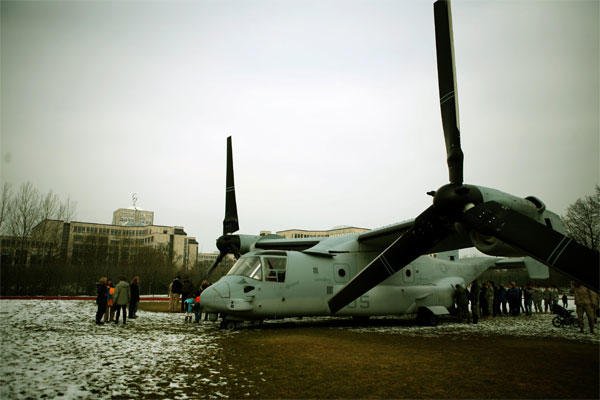STUTTGART, Germany -- In coordination with U.S. Marine Corps Forces Europe and U.S. Marine Corps Forces Africa, the community of U.S. European Command, U.S. Africa Command, and USAG Stuttgart had “hands-on” experience with the MV-22B Osprey during a capabilities exercise on Patch Barracks, Kelly Barracks, and Stuttgart Army Airfield, March 28. The MV-22B Ospreys are visiting from the Marine Tiltrotor Squadron 266 (Reinforced), 26th Marine Expeditionary Unit, II Marine Expeditionary Force, based out of Camp Lejeune, N.C.
Part of the event was to introduce the MV-22B Osprey, which is a recent addition to the Marine Corps’ aviation inventory, to the EUCOM and AFRICOM combatant commands.
“I think it’s the future of how we’re going to provide medium-lift assault support in many ways,” said Lt. Col. Chris J. Boniface, the commanding officer of VMM-266, 26th MEU, II MEF.
For the exercise, three MV-22B Ospreys flew from an aircraft carrier on the Atlantic Ocean, past Rota, Spain, to Stuttgart, Germany, two days ago without having to land; a total of 1,400 nautical miles.
“It’s very important that we demonstrate this capability that the Marine Corps brings to the commands in the assault-support realm,” said Boniface, the Enterprise, Ala., native.
The MV-22B Osprey is a multi-engine, dual-piloted, self-deployable, medium-lift, vertical-takeoff and landing, tilt-rotor aircraft designed for combat support and special-operations missions. It combines the functionality of a helicopter with the performance of a turbo-prop aircraft.
“It’s the only airplane that can do everything a helicopter can,” said Capt. Erik B. Kolle, an MV-22B pilot, VMM-266, 26th MEU, II MEF. “It has proven in the last several years that it is a good choice,” added the Raleigh, N.C., native.
The MV-22B represents new capabilities in the region and can provide Marine Forces Europe and Marine Forces Africa a unique asset supporting their mission to respond to crisis, build partner-nation military capacity, promote regional security, and maintain a stabilization presence as directed by EUCOM and AFRICOM to protect U.S. national security interests.
“It takes the Mediterranean Sea, for example, and turns it into a lake,” said Kolle, regarding the rapid travelling capability of the MV-22B.
“Before, if a MEU wanted to reach an area, they would have to bring the ships closer to that region and deploy helicopters. Now, with the MV-22B, you can have a MEU floating in Spain and have troops on the other end of the Mediterranean the same day,” said Kolle.
“If AFRICOM and EUCOM are going to have MV-22Bs in their areas of responsibility, it’s important to know how to employ these assets in the event that something happens,” added Kolle.
Within the EUCOM and AFRICOM areas of responsibility, most bi-lateral and multi-lateral exercises with allied and partner nations could be supported with combat-proven air support provided by the MV-22B that other aircrafts, like the C-130 Hercules cargo plane, which requires a run-way for takeoff and landing, would prove less effective.
“I think the capabilities to fly as fast, and as far, as we can is significant in this area,” said Cpl. Justin J. Whiteman, an MV-22B crew chief, VMM 266, 26th MEU, II MEF.
To demonstrate the versatile landing capability of the MV-22B, two aircraft flew from Stuttgart Army Airfield, landing one on Kelly Field, Kelly Barracks, and the other landing on Husky Field, Patch Barracks.
“We can do 280 knots and put troops into a variety of landing terrains and conditions; unpaved areas, mountain sides, dusty zones. Airplanes and helicopters just can’t do that,” said Whiteman, the Lancaster, Penn., native.
“I think it’s critical for quick-response teams to be able to get to places that are great distances apart and the MV-22B is just that; ‘quick response,’” said Whiteman.
The aircraft, which reached its initial operation capability in 2007, has proven its operational efficacy with its ability to fly twice as fast, carry three times the payload, go twice as high, and travel almost five times the distance of other legacy medium-lift helicopters.
“The Osprey provides an awesome capability,” said Boniface. “It can aerial refuel, climb up to 25,000 feet; it does anything the commander needs it too, from embassy reinforcement to tactical recovery of personnel missions and raids.”
The MV-22B replaces the Marine Corps’ CH-46 “Sea Knight” helicopter’s role in functioning as the Marine Corps’ amphibious assault transport of troops, equipment and supplies, between sea and land.
“The CH-46 was a great aircraft, but that was 1960’s technology; this is the new millennium’s technology and it’s being upgraded along the way as we learn new lessons from other [Overseas Contingency Operations],” said Lt. Col. Rick Coates, a future operations officer, Marine Forces Europe.
Beyond the 1,400-mile flight, to show the long-range raid ability of the Osprey, the capabilities exercise included flights around the city, a tour of the aircraft, and contact with a knowledgeable and experienced crew to answer questions.
“The combatant commanders here are getting to see how, if they owned an amphibious readiness group, they will own a force that can go out and influence their area of responsibility,” said Coates.
“We are used to operating in big countries, like Iraq and Afghanistan, but they are still countries. Europe and Africa are continents!” said Coates.
“When you have this aircraft, with all the capabilities that it brings, you shrink the battle space and the distance won’t work against you,” said Coates. “It’s getting the job done in every clime and place; you can really reach out and touch anybody.”
The event also gave the USAG Stuttgart community a chance to see an aircraft that doesn’t typically operate within the Stuttgart airspace.
“This is a great opportunity and the hard work that everyone put into planning this has really paid off,” said Coates. “The tax payers are also getting to see the aircraft. The air-base communities in America are used to seeing Ospreys, but other places never get to see them, so it’s important to reach out to the American people here in Germany to show them what their military is doing.”





























